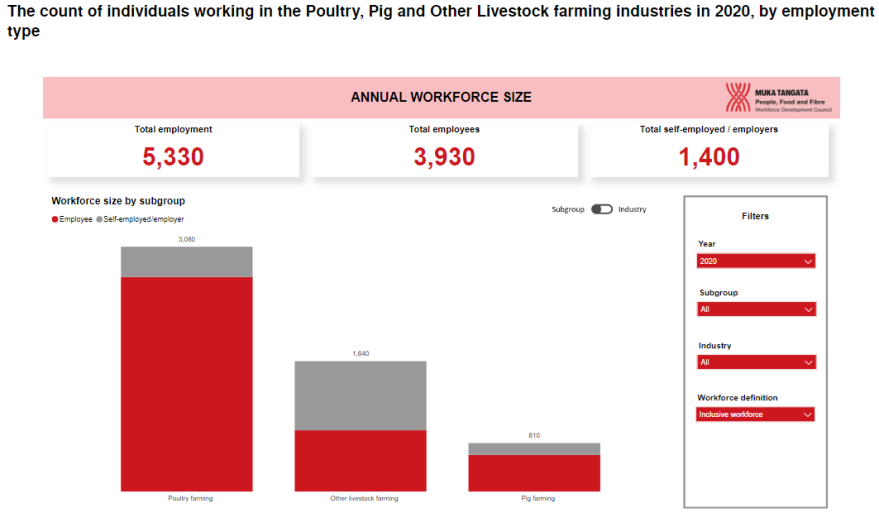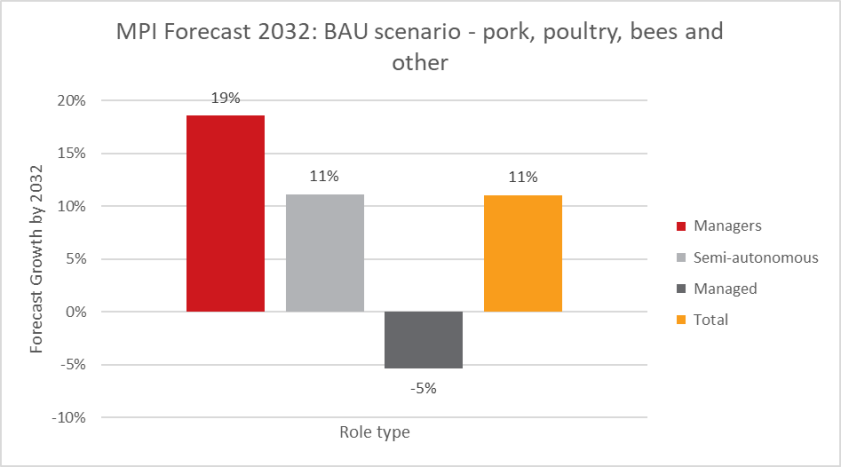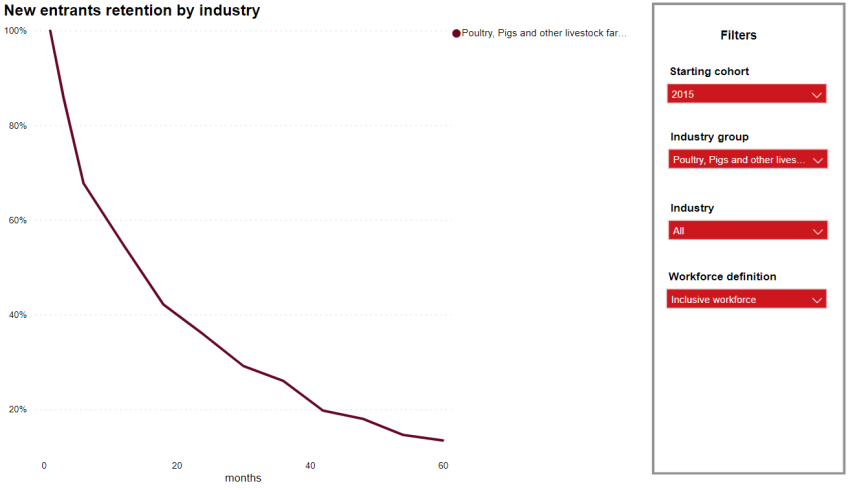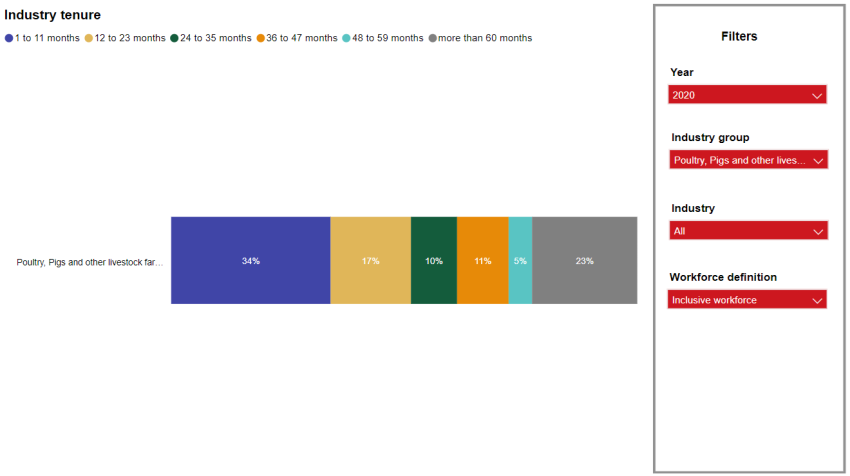Our Poultry, Pigs and Other Livestock Farming Workforce Development Plan contains further analysis of Industry, Workforce and Learner data trends.
Pork, Poultry and Other Livestock industry trends
These industries have been through significant changes from regulation, business model and technological changes. These all drive the need for new skills to be brought into the sector.
The Poultry and Pork industries have both been going through some significant changes over the past year, which on the surface are largely down to changes in government regulations around animal welfare. However, for the Poultry industry, the country’s two major supermarket chains have announced changes to their supply based on changing consumer demands, which is resulting in additional pressure on the industry to change their practices. Neither Poultry nor Pork have substantial export markets, but New Zealanders contribute locally to keep these industries in demand. In fact, we eat nearly 240 eggs per person per year, which equates to $286 million worth of eggs being sold1. The local Pork market is quite small, with 60% of the pork consumed in Aotearoa coming from overseas. In 2022, total revenue for the Poultry Meat and Eggs industry was $687.4 million and is forecast to increase at 2.5% year on year until 2028. However, we understand anecdotally that when regulatory changes banning caged egg farming were introduced in December 2022, some egg farms closed permanently. This caused significant disruption to the market, which no longer had enough supply to meet demand.
Pork, Poultry and Other Livestock workforce trends
The ‘Pork, Poultry, Bees and Other Sector’ workforces are forecast to increase by at least 11% by 2032 with increases being particularly concentrated in higher skill role types that will require increased levels of training. The workforce currently has low levels of formal qualifications and would need a substantially higher than requested level of investment to reach industry benchmark parity (see Appendix C for more detail on the methodology). The workforce has low new entrant retention rates and low levels of industry tenure which drive a need for training of replacements and has historically relied on high levels of migrants to fill skilled roles.
Pork, Poultry and Other Livestock workforce overview and highlighted demographics
The total workforce count across all of Poultry, Pigs and other Livestock farming was 5330 people in 2020. The number of people who identified as Māori in 2020 is higher for both learners (19%) and the workforce (25%) in the Poultry industry, compared to the Pork industry where 8.7% of learners and 7% of the workforce identified as Māori. In 2020, there were also more female learners (51.5%) and females in the workforce (44%) in the Poultry industry than in the Pork industry (32.1% of learners and 31% of the workforce identified as female). Across the wider Poultry, Pigs and other Livestock farming industry, 19% of the workforce identified as Māori and 43% as female in 20202.
The Pork industry requires more specific skills due to the requirements of the work, and has historically filled these skilled roles with migrants, but COVID-19 has made this harder. While it appears that there is a low uptake in qualifications, it is unclear if COVID-19 and labour shortages have exacerbated this.

Pork, Poultry and Other Livestock workforce forecasts
MPI forecasts, using the conservative ‘BAU Scenario’, are for an increase in worker numbers – particularly in higher skill level roles. We have mapped these forecasts to the roles and related qualifications for each of our industries and used them as an input to the level of increase requested for each qualification. See Appendix A: Translating MPI workforce forecasts to learner enrolment numbers for more details.

Pork, Poultry and Other Livestock workforce retention and tenure
The Pork, Poultry and Other Livestock workforce has a low level of new entrant retention and a low level of industry tenure. This replacement demand also is a driver of training requirements in this industry. This training is not lost to the sector – over a third of new entrants to Muka Tangata industries come from another Food & fibre industry and our qualifications are increasingly focused on transferable skills. Specialised education and retention are associated with retention – so increased training is expected to support retention within the industry and broader sector.


Which specific qualifications and credentials do you want to see growth in (that can be supported by TEC investment in 2025)?
| Qualification or credential | Mode | Specific regions? | Scale of change you are seeking for 2025 | Evidence of workforce need – include as text below the table or an attachment | Evidence that this provision will meet the workforce need | WDC-assigned priority level (for this advice) |
| New Zealand Certificate in Pork Production (Stockperson) (Level 3) [Stranded] [2525] | Learner numbers for this qualification have been consistently low. As such, we expect any increase in enrolments to be able to be met. |
There is demand from industry driven by forecast workforce growth across the related industries, significant gaps in the qualification level of the workforces, demographic challenges and the need to adapt to changing regulatory and business practices. The pork industry is relatively small in terms of workforce and traditionally has relied on lower skilled workers – the industry has a very high level of workers with no qualifications. The pork industry wants to change that situation by increasing skills levels, especially upskilling to meet new regulations for animal welfare; land and water use; and protection and to improve productivity to remain competitive against international competition, and providing better career paths to aid attraction and retention. But its learner numbers will never be large. |
The New Zealand Certificate in Pork Production (Stockperson) (Level 3) provides the pork production industry with individuals who have the knowledge and skills to assist with all aspects of pig feeding and health in a pig unit. It enables employees to improve skills and knowledge which enables the industry to remain internationally competitive, and also enhances their own employment opportunities across the pork production industry (supporting career pathways and retention). The community benefits by having trained people who are able to manage biosecurity risks and waste management within their workplaces, thereby reducing the potential to negatively affect the wider community and nation. |
|||
| New Zealand Certificate in Poultry Production (Level 3): Poultry Egg Production, Poultry Hatchery, and Poultry Rearing [2932] | Should a programme be available, we expect any enrolments to be small. |
There is demand from industry driven by forecast workforce growth across the related industries, significant gaps in the qualification level of the workforces, demographic challenges and the need to adapt to changing regulatory and business practices. The poultry industry is relatively small in terms of workforce and traditionally has relied on lower skilled workers – the industry has a very high level of workers with no qualifications. The industry wants to change that situation, increasing skills levels, especially as compliance regulation increases, and providing better career paths to aid attraction and retention. But its learner numbers will never be large, and they are struggling to get programmes designed. For example, this qualification currently has no programme available. |
The New Zealand Certificate in Poultry Production (Level 3) is ideal for people who may have entry level experience in the sector, or a desire to work in the poultry industry and want to develop their skills and knowledge in a specific operation of a poultry facility. The qualification provides the poultry industry with individuals who have the skills and knowledge to assist with a range of core tasks relevant to the poultry industry. |
|||
| New Zealand Certificate in Poultry Management (Level 4): Poultry Egg Production, Poultry Hatchery, and Poultry Rearing [2933] | Should a programme be available, we expect any enrolments to be small. |
As part of the industry’s aim to increase skills levels, especially as compliance regulation increases, and providing better career paths to aid attraction and retention, it is looking to develop better leadership skills. As noted above, learner numbers will never be large, and they are struggling to get programmes designed. For example, this qualification currently has no programme available. |
The purpose of the New Zealand Certificate in Poultry Production (Level 3) is to provide the poultry industry with experienced individuals who have the skills and knowledge to take responsibility for the day to-day operational management of a section in a poultry facility. This qualification is targeted at poultry employees who aspire to move from a poultry production role and pathway into a management role in a section of a poultry facility. |
|||
| New Zealand Certificate in Pork Production (Management) (Level 4): Optional strand in Pig Farm Production Planning [4222] | 30 learners |
There is demand from industry driven by forecast workforce growth across the related industries, significant gaps in the qualification level of the workforces, demographic challenges and the need to adapt to changing regulatory and business practices. The industry is looking to raise skills levels, including to meet compliance regulation changes, and better leadership skills. This qualification currently has no programme available, but industry has secured agreement to have a new programme developed to be available for 2025. This programme will cover identified skills needs including biosecurity, feeding, health and reproductive programmes for a pig farm, and also some leadership training in the way of preparing learners to supervise staff. Only a maximum of 30 learners are expected. |
Graduates of the New Zealand Certificate in Pork Production (Management) (Level 4) will have pig husbandry and farm management knowledge which will support the industry to be internationally competitive and enhance their own employment opportunities in key management roles across a pig farm and throughout the pork industry. The community will benefit by having trained people who are competent in operating a pig farm in an efficient and sustainable manner to maximise pork production. |
Which specific qualifications and credentials do you want to see changes in?
As we note in our overarching advice, we have not been specific about mode at a qualification level. However, in general, we recommend a preference for workplace training as part of the mix of the provision across all of our industries. This could include both work-based training and campus-based learning that include a strong component of practical ‘on job’ experience in a workplace setting.